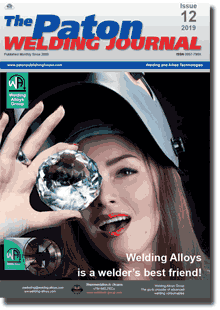| 2019 №12 (05) |
DOI of Article 10.15407/tpwj2019.12.06 |
2019 №12 (07) |

The Paton Welding Journal, 2019, #12, 48-55 pages
Journal The Paton Welding Journal
Publisher International Association «Welding»
ISSN 0957-798X (print)
Issue #12, 2019 (December)
Pages 48-55
Effect of extrusion modifiers of coating mixture on electrode coating thickness difference
A.E. Marchenko1, M.F. Gnatenko2 and N.V. Skorina1
1E.O. Paton Electric Welding Institute of the NAS of Ukraine 11 Kazymyr Malevych Str., 03150, Kyiv, Ukraine. E-mail: office@paton.kiev.ua
2WELMA LLC 3 Kaunasskaya Str., 02160, Kyiv, Ukraine
The method of oscillographing the signals generated by electromagnetic sensor, through the channel of which the electrodes pass at the outlet of the press coating head, was used to study the effect of extrusion modifiers of the coating mixture on thickness difference in manufacture of test electrodes UONI 13/55 of 4 mm diameter. The phenomenon of reduction of coating thickness difference under the effect of modifiers (CMC, alginates, cellulose or soda ash) is explained by that the dose of liquid glass added to the mixture gradually increases with the change of the type and increase of the content of modifier. Hydrating of modifying additive particles as a result of absorption of liquid glass moisture leads to thickening of the glass, and of its intergranular layers in the coating mixture, and to weakening of Hamaker interaction of filler grains. Probability of generation and accumulation of elastic stresses during extrusion application of the mixture on the rods becomes lower. The ability of the coating mixture flow to cover the rods in a uniform concentric layer at crimping of the electrodes becomes higher, accordingly. 6 Ref., 1 Table, 11 Figures.
Keywords: coated electrode manufacturing, coating mixture, coating thickness difference, extrusion modifiers, liquid glass, coating viscosity, electrode quality
Received: 17.09.19
Published: 30.01.19
References
1. Marchenko, A.E. (2017) Experimental studies of electrode coating thickness variation at pressing. The Paton Welding J., 1, 20-27. https://doi.org/10.15407/tpwj2017.01.032. Bernhardt, E. (1965) Recycling of thermoplastic materials. Moscow, Khimiya [in Russian].
3. Lavrenov, L.V., Marchenko, A.E., Shkurko, S.A (1975) Peculiarities of adsorption of alkaline silicates from liquid glass by marble and fluorite in electrode coatings. Avtomatich. Svarka, 3, 34–38 [in Russian].
4. Marchenko, A.E., Skorina, N.V. (2013) Influence of technological factors in manufacture of low-hydrogen electrodes on hydrogen content in the deposited metal. The Paton Welding J., 8, 13–24.
5. Marchenko, A.E., Gnatenko, M.F., Gorshkova, S.D. (1984) Method of evaluation of thermal softening of electrode paste. In: Inform. documents, CMEA, 1, 66–69 [in Russian].
6. Shelepov, E.P. (2000) Furnace of G-232 model for heat treatment of welding electrodes. In: Proc. of Sci.-Techn. Seminar on Electrode Manufacture on the Threshold of New Millennium (St.-Petersburg, 22–26 May, 2000). Cherepovets, 170–175 [in Russian].
